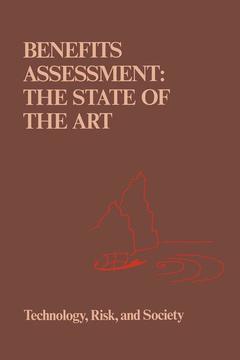Benefits Assessment, Softcover reprint of the original 1st ed. 1986 The State of the Art Coll. Risk, Governance and Society, Vol. 1
Langue : Français
Coordonnateurs : Bentkover J.D., Covello V.T., Mumpower J.L.

In recent years there has been substantial interest in benefits assessment methods, especially as these methods are used to assess health, safety, and environmental issues. At least part of this interest can be traced to Executive Order 12291, issued by President Ronald Reagan in 1981. This Executive Order requires Federal agencies to perform benefits assessments of pro posed major regulations and prohibits them from taking regulatory action unless potential benefits exceed potential costs to society. Heightened interest in benefits assessment methods has in tum given rise to greater recognition of the inherent difficulties in performing such assess ments. For example, many benefits that are intuitively felt to be most important are also among the most difficult to measure. It can be difficult to identify the full range of both benefits and costs. The choice of an appro priate discount rate for comparing benefits and costs over time is proble matic. Even when benefits are quantifiable in principle and agreement can be reached on their valuation, required d,ata may not be available. Thus considerable uncertainty is built into most benefit estimates, even when they are based on the best available data. In light of the complexities and difficulties associated with the perform ance of a benefits assessment, this book reviews the current state of theoretical and methodological knowledge in the field. The review is extensive in that it covers over fifty years of research, theoretical develop ment, and practice.
1. The Role of Benefits Assessment in Public Policy Development.- Historical overview of regulatory policy/Historical overview of benefits assessment/Valuation of health benefits/Assessment of safety Identification of environmental benefits.- 2. A Conceptual Overview of the Foundations of Benefit-Cost Analysis.- Theoretical foundations/The concept of benefits/The concept of costs/The role of time and uncertainty/Benefit-cost analysis in comparison with other frameworks.- 3. Benefits Assessment of Regulatory Problems.- Considerations in evaluating benefits of regulation/Benefits assessment within the policy process/Five-step procedure in applying Executive Order.- 4. Conceptual Framework for Regulatory Benefits Assessment.- Scope and terms of the analysis/Variables in benefits assessment/Empirical assumptions in benefits assessment methods/Choosing a method for benefits assessment/Using benefits assessments.- 5. Theory of Regulatory Benefits Assessment: Econometric and Expressed Preference Approaches.- Use of individual preferences to define benefits/The econometric approach/Time, risk, and uncertainty/A comparative evaluation of alternative approaches/The social utility framework for benefits assessment.- 6. General Methods for Benefits Assessment.- Direct monetary methods for evaluating public goods/Indirect monetary methods for evaluating public goods.- 7. The Valuation of Risks to Life and Health: Guidelines for Policy Analysis.- Willingness-to-pay principles/Adjustment in the value of life: quantity, quality, and heterogeneity/The human capital approach/Valuations using market data/Nonmarket valuations.- 8. Estimating the Be?efits of Environmental Regulations.- The structure of a benefits estimation model/Indirect methods for estimating individual usebenefits/Nonuse/ intrinsic benefits/Contingent choice.- Reviewers.
'The collection of papers, Benefit Assessment: The State of the Art, is carefully planned and comprehensive survey of the different methods needed for different purposes. It is by far the best source for practical use. The component papers are soundly based on fundamentals but recognize the practical problems of implementation and are tribute to the possibilities achievable with ingenuity and insight.'Prof. Kenneth J. Arrow, Stanford University, Nobel Prize Winner for Economics 1972'The authors and editors deserve warm congratulations on job well done. Their report is valuable survey of virtually all the methods now used to estimate and appraise the benefits of public regulatory programs, together with their conceptual foundations. Anyone involved in the process of regulatory assessment will benefit from its insights and from having it on his/her reference shelf.'Prof. Robert Dorfman, Harvard University'This book provides exactly what its title promises - the state of the art in benefits assessment. It is now the authoritative work in its field. Insofar as the subject will allow, Benefits Assessment is clear, succinct, helpful, and sophisticated.'Aaron Wildavsky, University of California
Date de parution : 10-2011
Ouvrage de 236 p.
16x24 cm
Thèmes de Benefits Assessment :
Mots-clés :
calculus; development; evaluation; foundation; human capital; public goods; public policy; valuation
© 2024 LAVOISIER S.A.S.


